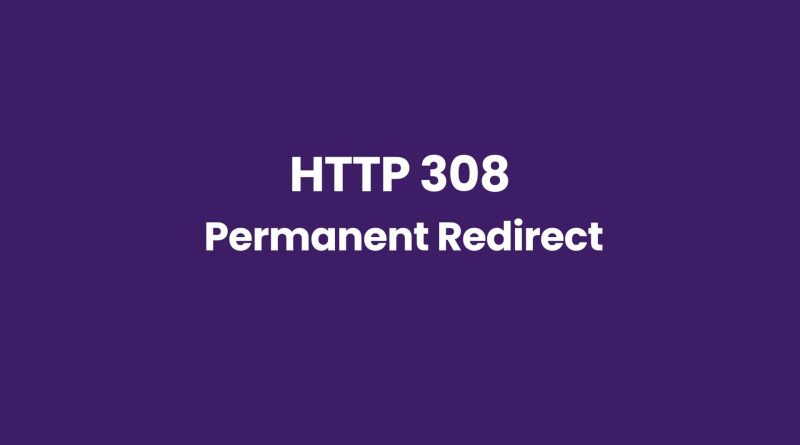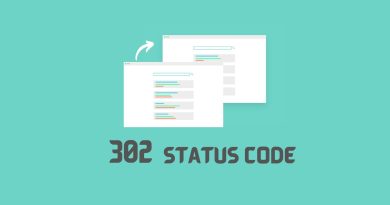HTTP 308 Permanent Redirect: The Ultimate Guide
Have you ever been frustrated by a seemingly permanent redirect? The HTTP 308 Permanent Redirect can be the answer to your woes. It is an incredibly useful and powerful tool for web developers, enabling them to improve their website’s performance and user experience. This guide will provide a comprehensive overview of how this redirect works and why it should be used in certain situations.
What is HTTP 308 Permanent Redirect?
HTTP 308 Permanent Redirect is an HTTP status code that lets a user agent know it needs to update the requested effective request URI with a preferred URI reference. It consists of an associated 3xx status code, typically delivered in response to a valid request from a client, where it contains a Location field value referencing the alternative resource that should be used instead.
For example, Suppose a user tries to access the following URL:
http://test.com/old-pageBut they have permanently moved the content to a new URL:
http://test.com/new-pageIn this case, the server will send an HTTP response with status code 308, indicating that the resource has been permanently moved. The response might look something like this:
HTTP/1.1 308 Permanent Redirect
Location: http://test.com/new-page
Content-Length: 0This response tells the user’s browser that the resource they were trying to access has permanently moved to a new URL. The “Location” header indicates the new URL where the content can be found, and the “Content-Length” header is set to 0 since there is no actual content in the response. The user’s browser will then automatically follow the redirect and load the new page at the new URL.
This type of redirect is permanent; any future attempts by the client to access this resource will result in the same redirection being followed.
The 308 status code differs from other 3xx codes because its purpose is specifically to denote that the requested effective request URI has been replaced permanently, while still allowing for backward compatibility with older browsers. The server must return a permanent redirect when all requests are meant to be directed towards another page on the site or external domain completely. Thus, it serves as an indication to both web crawlers and users alike, informing them of changes made within their website’s architecture or content structure.
What Is The Difference Between A 308 Status Code And A 307 Status Code?
A 308 Permanent Redirect is an HTTP status code that informs search engines and other clients that the requested resource has been moved permanently. It differs from a 307 Temporary Redirect, which tells search engines to continue indexing the original URL for a limited amount of time. The differences between these two codes go beyond just their method definition; understanding them can be helpful when considering explicit cache controls and other web server configurations.
The most obvious distinction between a 308 Permanent Redirect and a 307 Temporary Redirect lies in their respective methods definitions: A 308 redirects all requests made to the originating page, regardless of whether they are GET or POST requests, while a 307 will only affect the current request type (e.g., if it was originally sent as a POST request). Additionally, with both types of redirection, you must use an absolute URI within the Location header field to indicate where the redirected resource should be found.
Finally, although they serve similar purposes of informing clients that a requested resource has been moved permanently or temporarily respectively, there are also some subtle differences between how search engines react to each type of status code. For example, Googlebot may take longer to update its index after encountering a 300-level status code than it does when dealing with certain 301 redirects — so keep this in mind when making your decision on which one is best suited for your website’s needs. Transitioning into the next section on what is the difference between a 308 status code and a 301 status code?
What Is The Difference Between A 308 Status Code And A 301 Status Code?
A 308 Permanent Redirect and a 301 Moved Permanently are two of the most common types of redirects. Both are HTTP response status codes that indicate the requested resource has been assigned a new permanent URI (Uniform Resource Identifier) and any future requests should be directed to this address instead.
The main difference between these two is in the way they communicate their message: while both have a short hypertext note, only one adds an additional field called ‘Location’, which provides the new URL where it can find what was originally requested. This addition allows for more flexibility when configuring redirection messages as browsers or clients only need to read the Location header to know where to go next.
In terms of implementation, a 301 will require changing the original http method from POST/GET/etc., whereas a 308 does not mandate such changes; all that’s necessary is returning the appropriate status code along with the Location header value. It’s worth noting that although both mean ‘moved permanently’, search engines tend to prefer 301 responses over ones with status code 308 due to its unambiguity.
When faced with deciding on which option to use, bear in mind that if you ever want your site visitors and search engine crawlers alike redirected immediately, opt for sending out a 301 Moved Permanently response since it offers them precise instructions about how and where exactly they should be going next.
What Is The Difference Between A 308 Status Code And A 302 Status Code?
The difference between a 308 status code and a 302 status code is one of the most important distinctions to keep in mind when using permanent redirects. An HTTP response status code indicates whether or not an action was successful; specifically, codes beginning with 3 indicate redirection. The distinction between these two codes lies in their permanency – a 302 status code signals that the target resource has only been temporarily moved while a 308 definitively states it has been permanently relocated.
| HTTP Status Code | Usage |
|---|---|
| 302 | Temporary Redirect – Post to Get |
| 308 | Permanent Redirect – Non-Standard |
Whereas a standard GET request can be resubmitted upon receiving a 302 status code, with a 308 response, any additional post requests will also result in redirection rather than updating the content. This makes sense since the page’s location has changed, meaning information sent after getting the initial response would be irrelevant to the new address. In other words, once you’ve received a 308 response from your server, you know for sure that all subsequent requests should go to the target URL specified by this message.
How To Use 308 Http Status Code For A Website?
As mentioned earlier the 308 HTTP status code is used for a permanent redirect, providing a response from the server that future references of an incomplete upload should use the new URI – or Uniform Resource Identifier. This means that when visitors attempt to access your website, they are automatically redirected to the new URL instead. As such, it’s important to understand how best to implement this particular status code into your web pages.
Here are five key points:
- Utilise permanent redirects so as not to confuse users with unnecessary multiple URLs;
- Ensure all structured data in linked pages has been updated accordingly;
- Include relevant meta tags and page titles on both old and new URIs;
- Use relative paths where possible – especially when migrating content between domains;
- Test out all changes before making them live on your site.
Give me a chart indicating whether web browsers support HTTP 308 status code. Include all the famous web browsers
| Browser | Supports HTTP 308 Status Code |
|---|---|
| Chrome | Yes |
| Firefox | Yes |
| Edge | Yes |
| Safari | Yes |
| Opera | Yes |
| Internet Explorer | No |
Other Similar Status Codes To The 308 Http Status Code
In addition to the 308 Permanent Redirect, other HTTP response status codes can be used in web applications. Clients with link editing capabilities should automatically re-link references to the effective request URI. The following table outlines some of these other status codes and provides details on their full support:
| Status Code | Description | Support |
|---|---|---|
| 301 | Moved Permanently | Full |
| 302 | Found (Previously “Moved temporarily”) | Partial(IE not supported) |
| 303 | See Other | Full |
| 307 | Temporary Redirect | Full |
The purpose of these different types of redirects is to allow changing the request type from one form to another without the user being aware of it. A permanent redirect will generally cause a client’s cache definition or explicit caching rules for that resource to become invalidated. Therefore, it is important for developers and system administrators to understand how best to use these various responses when creating web applications for their users. This guide has provided an overview about using the 308 Permanent Redirect HTTP Status code and its general uses cases as well as similar alternatives available when managing requests over the internet. With this information, readers now have a better understanding of how they can apply such techniques while developing robust applications across the web.
All HTTP status codes by categories
Informational responses
(100 – 199)



